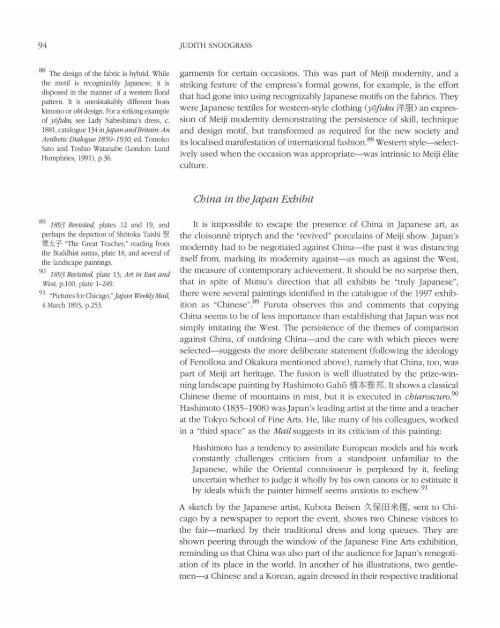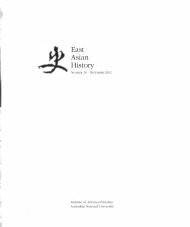Exhibiting Meiji Modernity: Japanese Art at the ... - East Asian History
Exhibiting Meiji Modernity: Japanese Art at the ... - East Asian History
Exhibiting Meiji Modernity: Japanese Art at the ... - East Asian History
- No tags were found...
You also want an ePaper? Increase the reach of your titles
YUMPU automatically turns print PDFs into web optimized ePapers that Google loves.
94<br />
JUDITH SNODGRASS<br />
88 The design of <strong>the</strong> fabric is hybrid. While<br />
<strong>the</strong> motif is recognizably <strong>Japanese</strong>, it is<br />
disposed in <strong>the</strong> manner of a western flora l<br />
p<strong>at</strong>tern. It is unmistakably different from<br />
kimono or obi design. For a striking example<br />
of yojuku, see Lady Nabeshima's dress, c.<br />
1881, c<strong>at</strong>alogue 134 inJapanandBritain: An<br />
Aes<strong>the</strong>tic Dialogue 1850-1930, ed. Tomoko<br />
S<strong>at</strong>o and Toshio W<strong>at</strong>anabe (London: Lund<br />
Humphries, 1991), p.36.<br />
garments for certain occasions. This was part of <strong>Meiji</strong> modernity, and a<br />
striking fe<strong>at</strong>ure of <strong>the</strong> empress's formal gowns, for example, is <strong>the</strong> effort<br />
th<strong>at</strong> had gone into using recognizably <strong>Japanese</strong> motifs on <strong>the</strong> fabrics . They<br />
were <strong>Japanese</strong> textiles for western-style clothing (yofuku #~&) an expression<br />
of <strong>Meiji</strong> modernity demonstr<strong>at</strong>ing <strong>the</strong> persistence of skill, technique<br />
and design motif, but transformed as required for <strong>the</strong> new society and<br />
its localised manifest<strong>at</strong>ion of intern<strong>at</strong>ional fashion. 88 Western style-selectively<br />
used when <strong>the</strong> occasion was appropri<strong>at</strong>e-was intrinsic to <strong>Meiji</strong> elite<br />
culture.<br />
China in <strong>the</strong> Japan Exhibit<br />
89 1893 Revisited, pl<strong>at</strong>es 12 and 19, and<br />
perhaps <strong>the</strong> depiction of Sh6toku Taishi ~<br />
1!:t:r "The Gre<strong>at</strong> Teacher," reading from<br />
<strong>the</strong> Buddhist sutras, pl<strong>at</strong>e 18, and several of<br />
<strong>the</strong> landscape paintings.<br />
90 1893 Revisited, pl<strong>at</strong>e 13; <strong>Art</strong> in <strong>East</strong> and<br />
West, p.lOO, pl<strong>at</strong>e 1- 249.<br />
91 "Pictures for Chicago," Japan Weekly Mail,<br />
4 March 1893, p.253.<br />
It is impossible to escape <strong>the</strong> presence of China in <strong>Japanese</strong> art, as<br />
<strong>the</strong> cloisonne triptych and <strong>the</strong> "revived" porcelains of <strong>Meiji</strong> show. Japan's<br />
modernity had to be negoti<strong>at</strong>ed against China-<strong>the</strong> past it was distancing<br />
itself from, marking its modernity against-as much as against <strong>the</strong> West,<br />
<strong>the</strong> measure of contemporary achievement. It should be no surprise <strong>the</strong>n,<br />
th<strong>at</strong> in spite of Mutsu's direction th<strong>at</strong> all exhibits be "truly <strong>Japanese</strong>",<br />
<strong>the</strong>re were several paintings identified in <strong>the</strong> c<strong>at</strong>alogue of <strong>the</strong> 1997 exhibition<br />
as "Chinese".89 Furuta observes this and comments th<strong>at</strong> copying<br />
China seems to be of less importance than establishing th<strong>at</strong> Japan was not<br />
simply imit<strong>at</strong>ing <strong>the</strong> West. The persistence of <strong>the</strong> <strong>the</strong>mes of comparison<br />
against China, of outdoing China-and <strong>the</strong> care with which pieces were<br />
selected-suggests <strong>the</strong> more deliber<strong>at</strong>e st<strong>at</strong>ement (following <strong>the</strong> ideology<br />
of Fenollosa and Okakura mentioned above), namely th<strong>at</strong> China, too, was<br />
part of <strong>Meiji</strong> art heritage. The fusion is well illustr<strong>at</strong>ed by <strong>the</strong> prize-winning<br />
landscape painting by Hashimoto Gah6 m*~*~ . It shows a classical<br />
Chinese <strong>the</strong>me of mountains in mist, but it is executed in chiaroscuro 90<br />
Hashimoto (1835-1908) was Japan's leading artist <strong>at</strong> <strong>the</strong> time and a teacher<br />
<strong>at</strong> <strong>the</strong> Tokyo School of Fine <strong>Art</strong>s. He, like many of his colleagues, worked<br />
in a "third space" as <strong>the</strong> Mail suggests in its criticism of this painting:<br />
Hashimoto has a tendency to assimil<strong>at</strong>e European models and his work<br />
constantly challenges criticism from a standpoint unfamiliar to <strong>the</strong><br />
<strong>Japanese</strong>, while <strong>the</strong> Oriental connoisseur is perplexed by it, feeling<br />
uncertain whe<strong>the</strong>r to judge it wholly by his own canons or to estim<strong>at</strong>e it<br />
by ideals which <strong>the</strong> painter himself seems anxious to eschew.91<br />
A sketch by <strong>the</strong> <strong>Japanese</strong> artist, Kubota Beisen :7-. f:!f: EEl *~, sent to Chicago<br />
by a newspaper to report <strong>the</strong> event, shows two Chinese visitors to<br />
<strong>the</strong> fair-marked by <strong>the</strong>ir traditional dress and long queues. They are<br />
shown peering through <strong>the</strong> window of <strong>the</strong> <strong>Japanese</strong> Fine <strong>Art</strong>s exhibition,<br />
reminding us th<strong>at</strong> China was also part of <strong>the</strong> audience for Japan's renegoti<strong>at</strong>ion<br />
of its place in <strong>the</strong> world. In ano<strong>the</strong>r of his illustr<strong>at</strong>ions, two gentlemen-a<br />
Chinese and a Korean, again dressed in <strong>the</strong>ir respective traditional
















